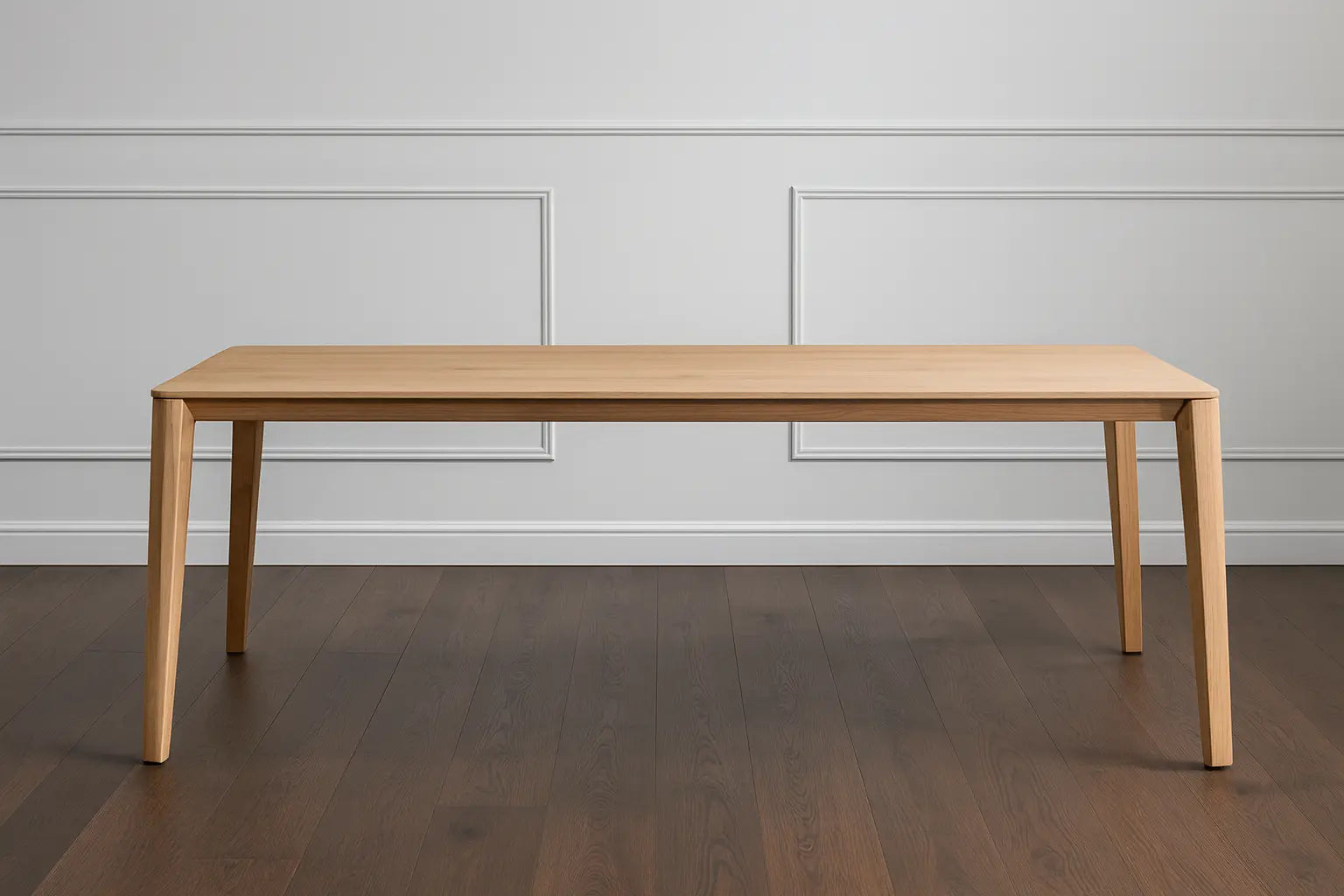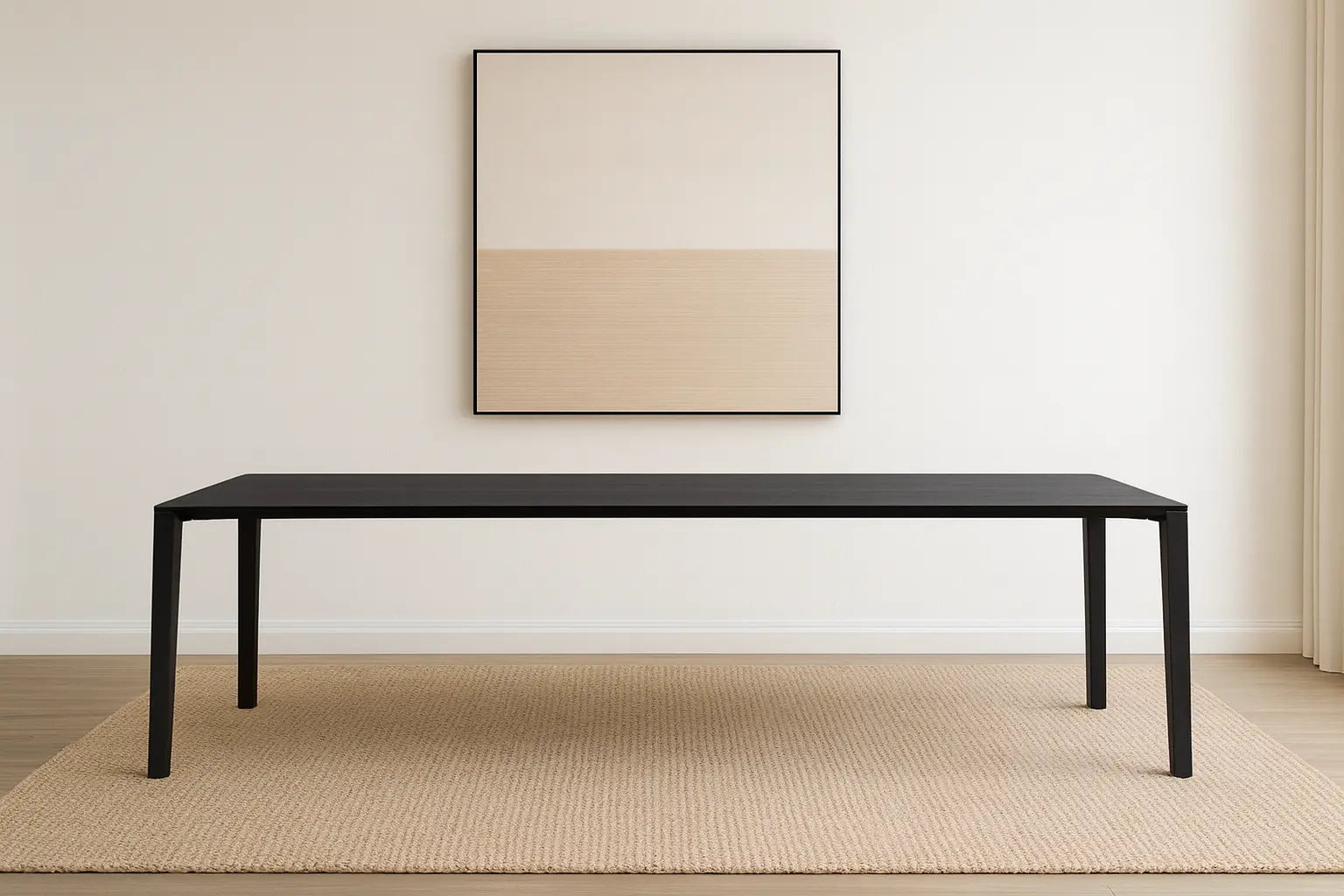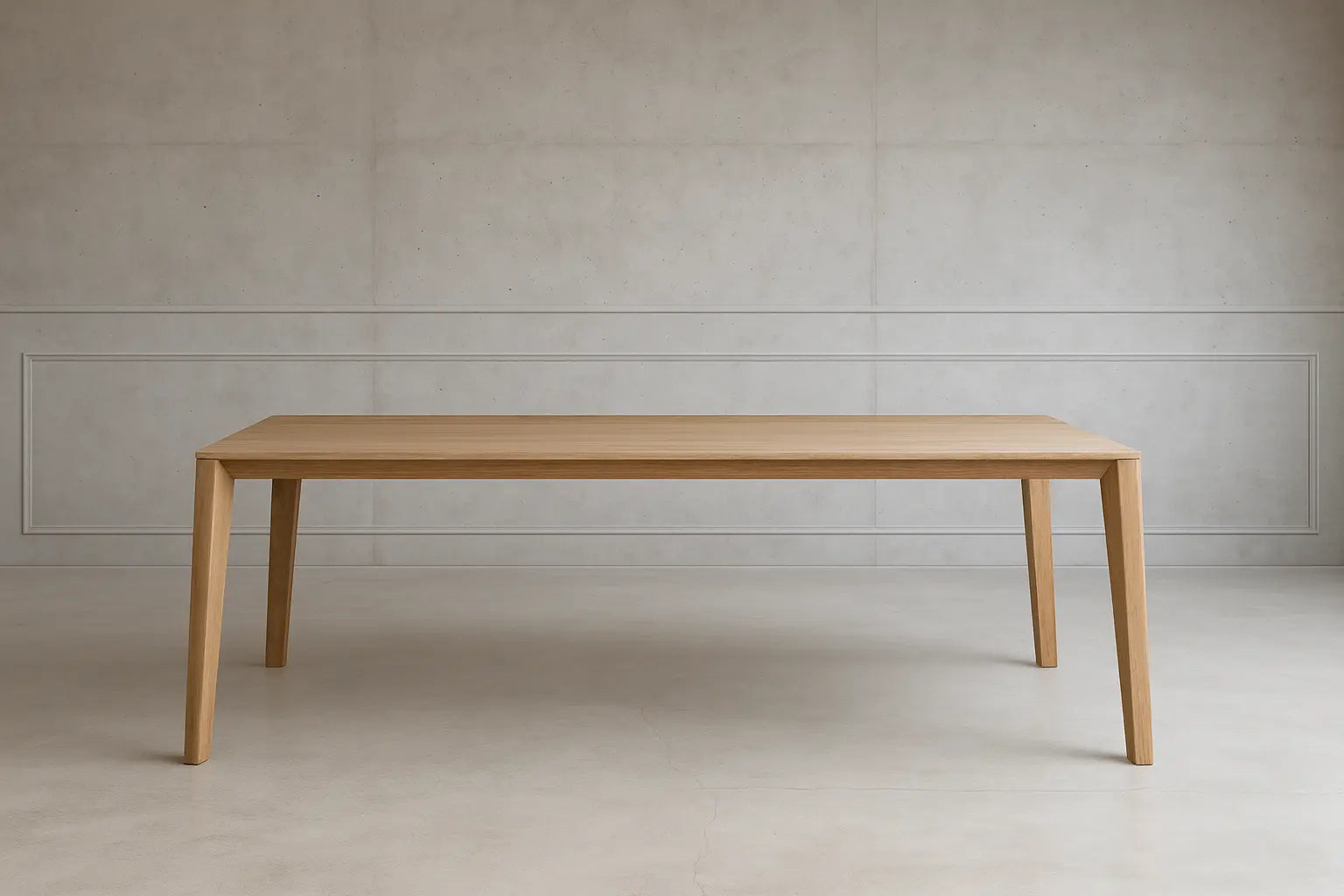"ARCO" table in black oak
"ARCO" table in black oak
Production and delivery
Production and delivery
Dimensions
Dimensions
surface
surface
• Black matt lacquered oak
• High-quality matt varnish from Germany with long-lasting color fidelity
• Visible wood structure with a silky finish
Design and structure
Design and structure
• Solid oak from European production
• Floating table top with precise transition
• Soft, rounded edges
• Metal reinforcement on the bottom for maximum stability
The ARCO table in matte black lacquered oak is a masterpiece of European furniture craftsmanship. With its floating tabletop, gentle curves, and flawless craftsmanship, it combines strength, harmony, and refinement.
The surface is finished with a high-quality, German-made matte varnish known for its exceptional durability and color fidelity. The matte finish emphasizes the natural structure of the wood and lends the tabletop depth and a pleasant feel.
The design This table's design is based on clean lines and a soft design language that perfectly complements modern and minimalist interiors. The precise joint between the tabletop and legs creates the characteristic "floating" effect, lending a sense of lightness to the entire silhouette.
Thanks to the integrated metal reinforcements in the lower section, the table remains stable and maintains its shape, even in larger formats up to 300 cm long. This combination of technical precision and natural beauty makes the ARCO an elegant centerpiece of any dining room.
Each piece is manufactured in Europe, carefully inspected, and finally assembled in Switzerland. The Martin Gabriel Home collection stands for high-quality materials, perfect craftsmanship, and sustainable production—selected for people who value aesthetics and durability.
Share this product
Couldn't load pickup availability

sustainability
We prioritize eco-friendly materials and responsible production to ensure beauty that respects both people and the planet.

Quality
From raw materials to the finished product, we adhere to the highest standards to deliver timeless pieces that exceed all expectations.

Care
Attention to detail is at the heart of our process, ensuring that every product reflects our passion for excellence.

design
Inspired by nature and a refined aesthetic, our pieces seamlessly combine craftsmanship, functionality, and timeless charm.
Indoor table and dining table



Vendor: Martin Gabriel Home
Type: Table Indoor
"ARCO" table in black oak
Frequently Asked Questions
What are the return conditions?
What are the return conditions?
We accept returns within 14 days of delivery. Items must be unused and in perfect condition. Please note that return shipping costs are the responsibility of the customer. To initiate a return, please contact our customer service.
How do I care for outdoor products?
How do I care for outdoor products?
Our outdoor cushions, rugs, and throws are durable and easy to care for. For regular cleaning, wipe them with a damp cloth or gently handwash them as needed. To preserve the quality and design of the fabric, avoid harsh chemicals.
Do you offer international shipping?
Do you offer international shipping?
Yes, we offer international shipping to select countries. Shipping costs and delivery times vary depending on your location. During the checkout process, you'll see all available options for your region.
Martin Gabriel Home Blog
Entdecke die lebensart in den schweizer alpen
Der Tag beginnt früh. Die Luft riecht nach Harz und nassen Steinen, die Kühe ziehen langsam an Ihrem Zaun vorbei, und hinter dem Satteldach des Nachbarhauses steigt ein dünner Rauchfaden in den Himmel. In den Schweizer Alpen ist Gelassenheit kein Trend, sondern eine Haltung. Wer hier lebt, misst den Wert des Tages nicht an erledigten Mails, sondern an klarem Licht, verlässlichen Händen und dem Wechsel der Jahreszeiten. Zwischen Gipfeln und Gelassenheit: Alltag, Kultur und Genuss Die alpine Lebensart entsteht im Spannungsfeld von Höhe und Nähe. Nähe zu Menschen, Tieren, Traditionen. Höhe als ständige Erinnerung daran, dass Wetter, Gelände und Zeit Grenzen setzen. Diese Grenzen schaffen Freiheit. Wer einen Hang bewirtschaftet, vergisst die Uhr. Wer im Dorfplatz einen Espresso trinkt, lernt schnell, dass ein kurzer Gruß ein langes Gespräch eröffnen kann. Lebensart meint hier Taktgefühl: für die Natur, für den Nachbarn, für das Material, das man bearbeitet. Holz, Stein, Milch, Wolle. Wer davon lebt, verbindet Respekt mit kluger Einfachheit. Werte, die den Alltag tragen Zeit ernst nehmen, ohne sich hetzen zu lassen Qualität vor Quantität Ehrliche Materialien, wenig Schnickschnack Sorgfalt bei Arbeit, Essen und Gastfreundschaft Begeisterung für das Naheliegende: Wasser, Brot, Käse, Sonne, Schatten Diese Werte sind kein romantischer Rückblick, sondern eine Entscheidung, die täglich neu getroffen wird. Ein Haus wird nicht hübsch, weil es alt ist. Es wird schön, weil es gut gepflegt ist. Sprachen als Heimat Vier Landessprachen prägen die Alpenräume: Deutsch, Französisch, Italienisch, Rätoromanisch. Ein Tal kann klingen wie ein anderes Land. Begrüßungen sind kleine Schlüssel. Deutschsprachige Täler: Grüezi, Grüessech, Hoi Westschweiz: Bonjour, Salut Tessin: Buongiorno, Ciao Graubünden: Allegra, Buna sera Wer grüßt, öffnet Türen. Wer zuhört, hört Unterschiede: Walser-Dialekte, Engadiner Melodie, das weiche Italienisch der Maggiatäler. Sprache ist Identität und Einladung zugleich. Baukultur: Zwischen Sgraffito und Schindel Die Häuser erzählen Geschichten. Ställe auf Stelzen, Engadiner Häuser mit Sgraffito-Ornamenten, Valser Holzbauten, abgedunkelt von Sonne und Zeit. Dachüberstände halten Regen fern, dicke Mauern kühlen im Sommer und wärmen im Winter. Das ist keine Nostalgie, sondern Funktion. Prinzipien, die man oft sieht: Bauen mit dem, was da ist: Lärche, Arve, Granit, Kalk Dichte Dorfkerne statt Zersiedelung Sanieren statt abreissen, Anpassen statt verbiegen Schlanke Technik, robust ausgeführt In vielen Tälern entstehen Werkstätten, die altes Wissen mit neuer Form verbinden. Eine Tür, die im Winter dicht schließt, ein Fenster, das Schatten wirft, ein Boden, der knarrt und hält. Schönheit ergibt sich aus Gebrauch. Essen als gelebte Kultur Wer an den Alpen denkt, denkt an Käse. Aber die Tische sind vielfältig. Trockenfleisch im Wallis, Capuns in Graubünden, Polenta im Tessin, Alpkäse und Butter, die nach Wiese schmecken. Die Küche ist bodenständig, aber raffiniert in der Balance. Ein paar Grundpfeiler: Saison zählt: Frühling Kräuter, Sommer Beeren, Herbst Pilze, Winter Gerichte aus dem Vorrat Kurze Wege: Was die Alp hergibt, findet Platz auf dem Teller Zeit für gemeinsames Essen, ohne Ablenkung Ein Abend kann so aussehen: Brot aus dem Holzofen, Rohmilchkäse aus dem Nachbartal, Tomaten, die Sonne gesehen haben, ein Glas Dôle oder ein Merlot aus dem Tessin. Dazu Gespräche, die nicht auf die Uhr schauen. Arbeiten auf der Alp Die Alp ist Arbeitsplatz, nicht Kulisse. Wer im Sommer hinaufzieht, lebt mehrere Monate mit Tierherden. Der Tagesplan: 04:30 Milchen 06:00 Käsen, Brot backen, Salzbad prüfen 10:00 Zäune kontrollieren, Wasserläufe richten 13:00 Mittagsruhe, Werkzeugpflege 15:00 Zweite Melkzeit 19:00 Kontrollgang, Wetter checken Die Produktion ist anstrengend und erfüllt. Ein Käselaib ist gespeicherte Landschaft. Man schmeckt Höhenmeter, Kräuter, Gestein. Traditionen wie Alpaufzug und Alpabzug sind mehr als Folklore. Sie markieren Übergänge, schaffen Gemeinschaft, geben den Tieren und Menschen einen feierlichen Tritt in neue Phasen. Glocken, Tannengrün, Blumenkränze, viel Lachen, manchmal Regen. Es gehört dazu. Bewegung, die gut tut Menschen in den Alpen bewegen sich viel. Nicht nur als Sport, sondern als Alltag. Treppen statt Lift, Tragen statt Rollen. Das macht etwas mit Körper und Kopf. Beliebte Aktivitäten: Wandern auf gut gepflegten Wegen Berglauf und Trailrunning für die, die mehr Puls wollen Klettern und Klettersteige Skitouren und Schneeschuhgehen Langlauf in weiten Tälern Velo, Gravel, Rennrad oder E-Bike Wer unterwegs ist, folgt Regeln, die sich eingebürgert haben: Wege respektieren, Weidegatter schließen Hunde anleinen, Herdenschutz beachten Rücksicht auf Wildruhezonen Abfälle mitnehmen Freundlich grüßen, auch wenn der Atem kurz ist Jahreszeiten als Taktgeber Der Frühling riecht nach Aufbruch. Wasser schießt in den Bächen, die ersten Krokusse drücken durch. Im Sommer steht das Gras hoch. Die Hitze ist anders als im Flachland, trockener, klarer. Abends ziehen Gewitterlinien über die Kämme, und die Luft ist danach frisch wie neu. Der Herbst ist ein großes Theater aus Gold und Kupfer. Lärchen legen ihr Festkleid an, Trauben reifen an den Südhängen. Der Winter bringt Ruhe und Präzision. Geräusche dämpfen, Wege werden klar, Sterne näher. Jeder Abschnitt hat eigene Tätigkeiten, eigenes Essen, eigenes Licht. Ein Gedanke, der oft fällt: Man arbeitet mit dem, was die Zeit gerade erlaubt. Im Sommer bauen, im Winter planen. Im Herbst ernten, im Frühling aussäen. Die Geduld, die daraus wächst, macht vieles leichter. Moderne Arbeitswelten in alten Tälern Glasfaser hat überraschend viele Dörfer erreicht. Co-Working-Spaces stehen in Andermatt, Brig, Davos oder Samedan offen. Meetings am Vormittag, ein schneller Aufstieg am Nachmittag, abends der Dorfchor. Es ist möglich. Und es verlangt Disziplin. Fragen, die man sich stellt: Wie bleibt Wohnen bezahlbar, wenn Zweitwohnungen Druck erzeugen Wie schützt man Ortsbilder, ohne Neues zu blockieren Wie bleibt Gastfreundschaft herzlich, ohne zur reinen Kulisse zu werden Viele Gemeinden antworten mit kluger Bodenpolitik, Kontingenten und einem starken Vereinsleben. Wer neu dazu kommt, wird eingeladen, mitzuschaffen. Ein Fest braucht immer Hände, die Holz aufschichten, Tische schleppen, Kuchen schneiden. Feste und Rituale im Jahreslauf Die Liste ist lang und liebenswert. Ein paar Beispiele, die das Lebensgefühl greifbar machen: Chalandamarz im Engadin, Anfang März, um den Winter auszutreiben Désalpe in der Westschweiz, wenn die Kühe ins Tal zurückkehren Schwingen auf grünen Ringen, kräftig, fair, mit Tradition Hornussen, eigenwillig und präzise Viehschauen, bei denen Zucht und Stolz nicht prahlen, sondern strahlen Silvesterchläuse im Appenzell, Gesang, Kostüme, Rhythmus Diese Feste sind nicht für Kameras erfunden worden. Sie funktionieren, weil sie zu den Menschen passen. Wer als Gast teilnimmt, spürt schnell, wie sehr Haltung zählt: nicht vordrängeln, nicht belehren, mit anpacken, wenn Hilfe gebraucht wird. Aromen, die bleiben Die Alpen schmecken unterschiedlich je nach Höhe, Tal, Wind. Ein paar Genussbilder: Engadin: Nusstorte, Bündnerfleisch, Gerstensuppe Wallis: Raclette, Aprikosen, Heida-Wein von alten Rebstöcken Tessin: Risotto mit Loto-Reis, Kastanien, Luganighe Berner Oberland: Alpkäse, Meringues mit Doppelrahm Innerschweiz: Älplermagronen, Birnenbrot, Kirsch Hier hilft eine kleine Übersicht. Region Sprache Signaturgericht Baukultur-Detail Tempo im Alltag Graubünden Deutsch/Romanisch Capuns, Pizzoccheri Sgraffito, Engadinerhaus Gleichmaß, klar Wallis Deutsch/Französisch Raclette, Trockenfleisch Speicher auf Stelzen Langsam, sonnig Tessin Italienisch Polenta, Risotto Steinplattendächer Lebhaft, herzlich Berner Oberland Deutsch Alpkäse, Rösti Chalets mit breiten Dächern Bedächtig, beständig Zentralschweiz Deutsch Älplermagronen Holzschindeln, Gaden Bodenständig, ruhig Die Unterschiede sind nicht absolut. Sie zeigen aber, wie viel Vielfalt in einem überschaubaren Raum steckt. Zeitformen: langsam, bewusst, fokussiert Die alpine Lebensart hat drei Zeitbegriffe, die man schnell lernt: Saisonzeit: Kalender der Arbeit, Ernte, Feste Tageszeit: Licht, Schatten, Temperatur, Lärmpegel Wetterzeit: Wenn das Gewitter ruft, wird der Plan geändert Wer danach lebt, organisiert sich anders. Aufgaben werden gebündelt, Wege geplant, Reserven angelegt. Das schafft Ruhe. Es nimmt Druck, weil Flexibilität eingeplant ist. Unterwegs mit Sinn Das Reisen in den Alpen hat seinen eigenen Stil. Die gelben Postautos kurven sicher in Täler, Züge gleiten pünktlich, Bergbahnen öffnen Höhen ohne Hektik. Wer das respektiert, nimmt sein Gepäck in zwei leichten Taschen mit, füllt die Trinkflasche mit Quellwasser und lässt den Rest zuhause. Ein paar nutzbare Hinweise: Bahn und Postauto verbinden fast jedes Dorf Hüttentouren früh reservieren, Hüttenschlafsack mitnehmen In Wildruhezonen Pausen still halten Klare Wetterregeln: Bei Gewitter nicht auf Grate Einkaufen im Dorf stärkt genau die Läden, die man dort sehen möchte Kleine Gesten mit großer Wirkung Grüßen, nicht rufen Saubere Schuhe am Hauseingang, besonders bei Holz Wasser sparsam nutzen, aber unbefangen trinken, wenn es als Trinkwasser markiert ist Müll trennen, Glas und PET zurückbringen Bar oder Karte beides bereithalten, kleine Läden freuen sich über Bargeld Wer mit dieser Haltung kommt, wird nie nur Gast sein. Man wird Mitmensch auf Zeit. Handwerk heute Die neuen Werkstätten riechen nach Öl, Holz und Neugier. Messer aus regionalem Stahl, Möbel aus Arve, Textilien aus Schafwolle, Naturfarben, die Wände atmen lassen. Junge Betriebe nutzen digitale Planung, ohne den Werkstoff zu vergessen. Ein Stuhl muss tragen, eine Fliese muss liegen, ein Dach muss halten. Alles andere ist Dekoration. Die Kooperation mit Landwirtschaft und Tourismus ist spürbar. Ein Gasthaus bezieht Brot aus dem Dorf, Käse von der Alp, Fleisch vom Tal, Bier aus der kleinen Brauerei am See. Die Wertschöpfung bleibt und stärkt das, was man später Lebensqualität nennt. Natur und Schutz Alpine Räume sind empfindlich. Wege, die jahrzehntelang halten, werden zerstört, wenn Wasser falsch abfließt. Wälder schützen vor Lawinen, Weiden halten Hänge stabil. Die Schutzkonzepte sind pragmatisch: Waldpflege, Wildruhezonen, Weideregimes, Wasserbau, Lawinenverbauungen. Dahinter stehen Menschen, die ihre Täler kennen. Sie arbeiten mit Karten, Sensoren und Intuition. Beides braucht es. Zwei Ideen für erlebnisreiche Runden ohne Stress Variante Nordost: Zürich nach Sargans, weiter ins Prättigau Zwei Tage Davos und Sertigtal, eine Hütte als Basis Bernina-Linie nach Poschiavo, italienischer Kaffee auf dem Platz Über den Lukmanier Richtung Disentis, Klosterbesuch, ruhige Wege Variante Südwest: Genfseeufer, Montreux, Weinberge von Lavaux zu Fuß Martigny, dann hinein ins Val de Bagnes Wanderung zur Alp, Käseverkostung direkt beim Senn Mit dem Zug über die Lötschberg-Achse ins Berner Oberland, Abend am Thunersee Beide Runden funktionieren ohne Auto und mit wenig Gepäck. Wer unterwegs im Dorf einkauft, nimmt ein Stück der Region mit nach Hause. Ein Blick in die Küche der Zeit Stellen Sie sich eine kleine Sennerei vor. Drei Kupferkessel, ein Holzofen, der gleichmäßig brennt, der Geruch von frisch geschnittener Milch. Die Hände der Sennerin sind ruhig, die Bewegungen präzise. Das Thermometer ist wichtig, ihr Gefühl wichtiger. Während der Bruch sinkt, erzählt sie von den Weiden, die heuer mehr Thymian tragen. Es wird ein würziger Sommer. Später im Gasthaus tritt der Wirt an den Tisch. Kein großes Menü, zwei Vorspeisen, drei Hauptgerichte, ein Kuchen. Man wählt nicht, weil es wenig gibt, sondern weil jede Wahl gut ist. Hinterm Haus steht der Kräutergarten, am Zaun lehnt das Fahrrad des Kochs. Der Abend gehört den Stimmen, die aus der Stube tragen. Orte, die den Takt halten Ein Dorfplatz mit Brunnen. Eine Bank in der Sonne, eine zweite im Schatten. Die Schule daneben, das Gemeindehaus gegenüber, die Kirche, deren Glocke nicht lauter ist als das Lachen auf der Stufe. Ein Laden, der nicht nur verkauft, sondern Neuigkeiten sammelt. Das Postauto hält pünktlich, die Hand hebt sich zum Gruß. Nichts Spektakuläres. Genau das ist der Punkt. Was bleibt Die alpine Lebensart ist keine Postkarte. Sie ist ein geübter Blick auf das Naheliegende und eine klare Entscheidung für Qualität und Maß. Man lebt nicht langsamer, man lebt bewusster. Man ist nicht gegen Neues, man bleibt den Grundsätzen treu, die tragen, wenn der Wind dreht. Wer das spürt, nimmt es mit in den eigenen Alltag. Vielleicht in Form einer Morgenroutine, die etwas früher beginnt. Vielleicht als fester Spaziergang nach dem Essen. Als ruhiger Tisch ohne Handy. Als handwerkliches Projekt am Wochenende. Als Lust auf Brot, das Zeit braucht, und Gespräche, die hängen bleiben. Ein Morgen mit Carlo, Bergführer aus dem Tessin Es ist 05:15, der Espresso läuft in eine kleine Tasse, die stark nach Porzellan riecht. Carlo prüft den Wetterbericht, zeichnet mit dem Finger eine Linie über den Grat. Die Gäste schlafen noch. Er weiß, dass der Wind gegen Mittag dreht. Also geht es früh. In seinen Rucksack kommen Seil, Helm, etwas trockene Wurst, Brot, Tee, ein Apfel. Keine großen Worte. Beim Aufstieg redet er leise. Über die Kastanienhaine, in denen er als Kind gespielt hat. Über seinen Vater, der ihm beigebracht hat, auch auf dem Pfad nie zu hasten. Oben nimmt er den Helm ab, schaut in die Runde und nickt. Als die ersten Wolken kommen, ist der Abstieg beschwingt. Unten im Dorf wartet die Bar, die um elf schon Leute kennt, die nichts Eiliges vorhaben. Es ist ein ganz normaler Tag. Genau darin liegt seine Besonderheit.
Learn moreKultur der Alpenregion: Traditionen und Bräuche
Morgens im ersten Licht klingen die Kuhglocken über die Hänge, der Atem steht wie feiner Dampf in der kühlen Luft, und irgendwo öffnet sich eine Stalltür. Wer so einen Moment erlebt hat, spürt unmittelbar, dass die Alpen keine Kulisse sind, sondern ein lebendiger Kulturraum. Die Eigenarten, die dort entstanden sind, tragen Spuren von Stein, Wetter, Höhe und Gemeinschaft. Sie sind kein Museum, eher ein Konzert, das seit Jahrhunderten gespielt wird, in dem neue Stimmen aber stets ihren Platz finden. Landschaft als Kulturbühne Steile Lagen prägen Gewohnheiten. Wo Felder terrassiert werden und Wege serpentinengleich zum nächsten Hof führen, entsteht eine Kultur der Genauigkeit, der Achtsamkeit gegenüber Material und Zeit. Arbeit wird in Rhythmen gedacht, im Einklang mit Jahreszeiten, Schneeschmelze, Alpauftrieb und Ernte. Das Alltagswissen ist fein verästelt: Welche Wiese wird wann gemäht, wie liest man Wolken, wie verhält sich der Hang nach einem Starkregen. Die Landschaft verbindet. Täler öffnen sich zu Pässen, Gipfel sind keine Grenzen, sondern Aussichtspunkte. Märkte über den Graten und säumende Karawanen prägten über Jahrhunderte soziale und wirtschaftliche Netze, in denen Salz, Käse, Stoffe, Wein und Geschichten zirkulierten. Kultur fließt hier in beide Richtungen, von Dorf zu Dorf, über Sprachgrenzen hinweg. Sprachen, Dialekte und Identität Die Alpen sprechen viele Sprachen, und ihre Dialekte tragen Geografie im Klang. Bayerisch und Tirolerisch, Alemannisch und Walliserdeutsch, Ladinisch in den Dolomiten, Romanisch im Engadin, Italienisch im Aostatal, Slowenisch in Kärnten und Friaul, Französisch in Savoyen. Diese Vielfalt ist kein Mosaik aus isolierten Steinen, eher eine Textur, in der Wörter wandern und Redensarten Spuren hinterlassen. Dialekte transportieren Lebenspraxis. Ein Wort für eine bestimmte Heugabel, eine Schneedecke, die trägt oder tückisch bricht, ein Ausdruck für das sanfte Antreiben von Vieh. Wer zuhört, hört Arbeit, Wetter, Nachbarschaft mit. Moderne Medien nivellieren manches, zugleich erlebt Mundart auf Bühnen, in Literatur und Musik eine selbstbewusste Pflege. Identität zeigt sich dabei nicht als Abschottung, sondern als offenes Bekenntnis zu Herkunft und Form. Feste des Jahres: Von Fasnacht bis Almabtrieb Der alpine Kalender kennt Takte, die weit über den Tourismus hinausreichen. Sie markieren Übergänge, danken für Gelingen, bändigen dunkle Kräfte oder laden die Gemeinschaft ins Dorfzentrum. Fasnacht und Perchtenläufe: Masken, Glocken, scheppernde Kostüme, die den Winter symbolisch vertreiben. Handgeschnitzte Larven zeigen wilde, urige Gesichter. Palmsonntag und Osterbräuche: Gebundene Palmbuschen, Prozessionen, regionale Speisen nach der Fastenzeit. Bergfeuer zu Johanni: Ketten aus Lichtpunkten über den Kämmen, Zeichen der Verbundenheit und ein uraltes Signal. Almauftrieb: Das Vieh zieht im Frühsommer auf die Höhen, begleitet von Musik und den Farben der Tracht. Almabtrieb oder Viehscheid: Die festlich geschmückten Kühe kommen ins Tal, wenn die Almsaison unfallfrei war. Ein bewegender Dank und zugleich Volksfest. Herbst- und Erntedank: Kränze, Körbe, Märkte, bei denen Käse, Nüsse, Trauben und Kastanien die Tische füllen. Advent und Nikolaus, Krampusumzüge: Zwischen Segen und Schaudern halten alte Formen ihren Platz. Jedes Tal färbt diese Feste anders. Manche Orte setzen auf Stille und Gebet, andere auf lärmende Umzüge mit Trommeln und Schellen. Gemeinsam bleibt die Erfahrung, dass Zeit nicht nur verstreicht, sondern gestaltbar ist. Musik, Klang und Tanz Musik klingt in den Alpen körpernah. Jodeln bewegt den Brustkorb, Alphorn und Büchel schicken lange Töne über die Flanken, das Hackbrett klirrt präzise, Geigenstimmen tänzeln auf Holzböden. Die Instrumente entstanden aus dem, was greifbar war: Holz, Darm, Metall. Ihr Klang ist an die Akustik der Höfe und Wirtshäuser angepasst, an Echo und Luftfeuchte. Tanz ist geselliges Handwerk. Beim Ländlertanz werden Figuren nicht auswendig aufgesagt, sie entstehen im Zusammenspiel. Der Schuhplattler ist mehr als Show, er ist Kommunikation, ein Wechselspiel aus Rhythmus und Gesten, oft humorvoll und schalkhaft. Moderne Formationen schließen daran an, mischen Jazz, Elektronik oder zeitgenössische Poesie mit Motiven aus der Volksmusik. So bleibt die Tradition lebendig, ohne museal zu wirken. Tracht, Handwerk und Material Tracht erzählt Herkunft und Status, aber vor allem erzählt sie von Materialkenntnis. Wolle, Leinen, Loden, feine Stickereien, Silberschmuck und Gamsbart sind Ausdruck einer Region und ihrer Ressourcen. Die Schnitte folgen Funktion, nicht bloß Mode. Eine Jacke soll wärmen, nicht imprägnierte Membran ersetzen, und sie soll Jahrzehnte halten. Handwerk bildet die Grundlage vieler Alltagsdinge: Holzschnitzerei, von religiösen Figuren bis zu Masken, die im Winter zum Einsatz kommen Drechselarbeiten und Küchengeräte, Schalen, Löffel, Butterschaufeln Flechten mit Hasel oder Weide für Körbe, Reusen, Trägennetze Filzen, Walken, Spinnen, Weben, die Herstellung von Lodenstoffen Schmiedearbeit für Beschläge, Riegel, Glocken Die Wertschätzung für Reparatur begleitet dieses Tun. Gebrauchsspuren gelten nicht als Makel, sie zeigen die Beziehung zwischen Mensch und Gegenstand. Nahrung aus steilen Lagen: Küche und Vorrat Steile Wiesen und kurze Sommer prägen die Küche. Konservierungstechniken wurden zur kulinarischen Kunst: Räuchern, Trocknen, Fermentieren, Einsalzen, Lagern in kühlen Kellern. Daraus entsteht eine Küche, die kräftig sein kann, aber feine Nuancen kennt. Knödel, Polenta, Rösti, Gerstensuppe, Buchweizen und Hirse in alten Rezepten, dazu Bergkäse, Speck, Trockenfleisch, Schüttelbrot, Nüsse und Honig. Die Alpküche ist arbeitstauglich. Ein Frühstück muss tragen, ein Abendessen stärken. Gleichzeitig kennt man Feste der Leichtigkeit, ein Kaiserschmarrn, der karamellisiert und fluffig ist, eine Marende mit Käse, Butter, Brot, Apfel und Wein. Eine Übersicht zeigt die Vielfalt: Region/Tal Spezialitäten Wichtige Merkmale Allgäu, Bregenzerwald Bergkäse, Kässpätzle, Riebel Milchreiche Landschaft, kräftige Hartkäse, einfache Mehlspeisen Berner Oberland, Wallis Alpkäse, Raclette, Trockenfleisch, Safran AOP-Traditionen, Walliser Safran, Weinbau in Steillagen Graubünden, Engadin Bündnerfleisch, Capuns, Pizokel Trocknungskunst, Buchweizen, Surselva-Kräuter Tirol, Salzburg Speck, Kaspressknödel, Schlutzkrapfen Presskäse in der Pfanne, gefüllte Teigtaschen Südtirol, Dolomiten Schüttelbrot, Schlutzer, Tirtlan, Lagrein Ladinische Einflüsse, Backkunst, autochthone Rebsorten Savoyen, Aostatal Fondue, Tartiflette, Fontina Käse aus Hochlagen, Kartoffelgerichte, robuste Küche Friaul, Kärnten Frigga, Polenta, Kletzenbrot Maiskultur, Trockenfrüchte, slowenische Einflüsse Käse stellt ein Kernkapitel dar. Sbrinz, Appenzeller, Comté aus dem Jura nahe den Voralpen, Gruyère, Fontina, Puzzone di Moena, Bitto, Vacherin, jede Sorte mit eigenem Mikroklima und eigener Reifung. Wer eine Alp besucht, sieht das Zusammenspiel aus Stallhygiene, Kesselfeuer, Lab, Zeit. Der Geschmack wird zur Landschaft in Scheiben. Architektur und Siedlungsformen Bauen am Hang heißt, mit Schwerkraft zu planen. Der klassische Blockbau dreht die Hölzer windgerecht, setzt sie auf einen steinernen Sockel, der vor Feuchte schützt. Walserhäuser zeigen eine raffinierte Leichtigkeit, Bregenzerwälderhäuser integrieren Wohn- und Wirtschaftstrakt unter einem weiten Dach. Engadinerhäuser mit Sgraffito zeugen von Stolz und handwerklicher Detailliebe. Die Schindel ist mehr als Verkleidung, sie ist ein atmender Schutz für das Holz. Steindächer liegen schwer und trotzen Stürmen. Stuben werden mit Kachelöfen beheizt, ihre Wärme zieht langsam in Möbel und Wände. Fensterbänke sind tiefer, um Licht zu fangen, und Lauben werden zu Übergangsräumen zwischen Außen und Innen. In vielen Orten prägen Trockenmauern die Hänge, halten Erde, bilden Lebensräume für Eidechsen und Kräuter. Arbeit am Berg: Alpwirtschaft und Rechte Alpwirtschaft ordnet die Höhen. Sie kennt die Sömmerung, die Aufteilung von Weideflächen, den Schutz junger Bäume, die Arbeit der Senninnen und Senner. Herdenschutz wird Teil des Alltags, wenn Wölfe und Bären zurückkehren, und Zäune, Hunde und Wissen müssen gemeinsam wirken. Heuet ist eine Choreografie, bei der Wetterfenster und Muskelkraft den Takt angeben. Jeder Handgriff hat Sinn, jede Stufe eines Heubodens erzählt vom Wintervorrat. Rechte auf der Alm sind historisch gewachsen, oft genossenschaftlich organisiert. Allmenden regeln Wasser, Wald, Weide, Wege. Diese Strukturen bewahrten über Generationen die Nutzung, ohne die Ressourcen zu erschöpfen. Konflikte gibt es, sie werden verhandelt, im Wirtshaus, in Gemeindestuben, vor Ortbegehungen. Entscheidungskultur ist Teil der Tradition. Mythen, Religion und Rituale Die Berge tragen Geschichten, die namenlos alt scheinen. Tatzelwurm, wilde Frauen, Riesen, verborgene Seen, die nicht gestört werden wollen. Solche Sagen erklären Gefahren, lehren Respekt vor Lawinenhängen und Wasserläufen. Religion hat vielerorts eine bergnahe Form. Wegkreuze, Marterln, Kapellen auf Sporn und Sattel, Prozessionen, die Pfade zeichnen. Wallfahrten verbinden Täler und schaffen Gemeinschaften über Grenzen hinweg. Rituale am Berg sind oft schlicht. Ein Segensspruch vor der ersten Mahd, ein stilles Kreuzzeichen, wenn das Vieh gesund zurückkehrt, eine Bergmesse zum Dank. In der Nacht leuchten Bergfeuer als Zeichen und als Fest. Die Kombination aus Glaube, Natur und Dorfgemeinschaft schafft eine eigene Haltbarkeit. Grenzräume und Netzwerke: Handel, Säumer, Pässe Die Alpen sind keine Mauer. Ihre Pässe sind Knotenpunkte, an denen Waren, Sprachen und Ideen wechselten. Säumer trugen Salz, Gewürze, Leinen, Käse. Wege wurden markiert mit Steinmännchen, Hospize boten Schutz. Mit dem Bau der großen Passstraßen und später der Tunnels wandelte sich die Dynamik, aber der Austausch blieb. Markttage brachten Dörfer zusammen, Verträge wurden mit Handschlag und Brot besiegelt. Handwerksgesellen wanderten, nahmen Lieder mit, hinterließen Techniken. Die Küche zeigt diese Verflechtungen, die Architektur ebenso. Ein Fensterriegel im Wallis kann ein Verwandter eines Werkstücks in Tirol sein, weil ein Schmied auf Wanderschaft war. Moderne Impulse: Tourismus, Schutz und Wandel Tourismus brachte Geld, Infrastruktur, Arbeitsplätze, zugleich neue Spannungen. Wer aufwächst, spürt die Chancen einer Bergführerausbildung, den Stolz, Menschen sicher auf Gipfel zu führen. Zugleich tritt die Frage auf, wie viele Betten ein Tal verträgt, wann Lärm schadet, wie man Pfade pflegt, ohne sie zu übernutzen. Die Diskussionen sind lebhaft und konstruktiv, sensible Lenkung zeigt Wirkung. Naturgefahren sind Teil des Systems. Lawinenverbauungen, Frühwarnsysteme, Wildbachverbauungen, Schutzwälder, Pflege von Bannzonen. Das Wissen älterer Generationen trifft auf Sensorik und Modellierung. Klimaveränderung verschiebt Vegetationszonen, Gletscher ziehen sich zurück, Permafrost schwindet. Gemeinschaften reagieren mit Ideenreichtum: Weidemanagement anpassen, Wasser speichern, Hänge stabilisieren, Bauweisen überdenken. Kulturelle Antworten werden sichtbar, wenn neue Feste alten Sinn bewahren und gleichzeitig nachhaltige Praktiken zeigen. Die Alpenkonvention und regionale Abkommen schufen einen Rahmen, in dem Schutz, Nutzung und Lebensqualität gemeinsam verhandelt werden. Das öffnet Türen für Projekte, die Landwirtschaft, Handwerk, Energie und Mobilität als vernetzte Themen begreifen. Kleinräumige Kreisläufe, gute Züge und Busse, bewusstes Bauen, regionale Märkte, all das wirkt zusammen. Wissenstransfer und Bildung im Hochformat Alpenvereine, Bergrettungen, Sennerkurse, Naturschutzgruppen und Dorfschulen sind Schulen ohne klassische Aula. Dort lernt man, wie ein Knoten hält, wann ein Hang bricht, wie eine Ziege gebärt, wie man ein Brett schindelt, was ein Gletscher erzählt. Dieses Lernen ist praxisnah, doch niemals antiakademisch. Hochschulen kooperieren mit Tälern, entwickeln Materialforschung für Holz, Strategien für Hangwasser, Konzepte für Tourismus, der langfristig trägt. Digitale Werkzeuge sind willkommen, wenn sie dienen. Eine App zeigt die Weidegrenze, ein Sensor meldet, wenn der Bach steigt, ein Satellitenbild hilft beim Waldumbau, eine Plattform bringt kleine Käsereien direkt zu Kundinnen und Kunden. Technik ergänzt, ersetzt aber nicht den Blick in den Himmel und das Gespräch am Gartenzaun. Stadt und Berg: Arbeitsteilung mit Zukunft Großstädte in Alpenrandlagen saugen Fachkräfte an und schicken Ideen zurück. Pendelbewegungen sind real, Co-Working in Bergtälern ist kein Exotikum mehr. Wer an drei Tagen im Tal arbeitet und zwei Tage in der Stadt, braucht verlässliche Netze, Zeitpläne, Kinderbetreuung, Gesundheitsversorgung. Gemeinden reagieren mit flexiblen Räumen, die Büro, Werkstatt und Kultur vereinen. Gleichzeitig wächst der Wunsch, regionale Wertschöpfung zu stärken. Eine Dorfbäckerei, die mit lokalem Getreide arbeitet, ein Sägewerk, das Totholz und Sturmholz klug nutzt, eine Energiegemeinschaft, die Wasserkraft mit Photovoltaik mischt. Aus kleinen Kettengliedern wird etwas Tragfähiges. Migration bringt neue Sprachen ins Tal, neue Rezepte, neue Handwerksideen. Offenheit macht die Alpen widerstandsfähig. Schutz der Ruhe: Klangordnung und Nacht Stille ist ein Gut. Sie lässt das Klingen der Kuhglocken zu Musik werden und gibt dem eigenen Atem Platz. Gemeinden definieren Ruhezeiten, Gastbetriebe sensibilisieren, Veranstalter planen mit Rücksicht auf Wildtiere und Anwohner. Lichtverschmutzung wird Thema, Sternennächte werden wieder sichtbar, wenn Lampen abgeschirmt und Bewegungsmelder klug eingestellt sind. Die Alpen können zeigen, wie Lebensqualität und Lebendigkeit zusammengehen, ohne den Himmel zu verlieren. Praktiken mit Zukunft Viele alpine Gewohnheiten bieten Antworten auf Fragen weit über die Täler hinaus. Sie sind konkret, unspektakulär und gerade dadurch wirksam. Reparieren statt Wegwerfen: Schuster, Schneiderin, Schmied, Schindelmacher. Ausbildung und Weitergabe dieser Fertigkeiten schaffen Berufe mit Sinn. Kreislaufwirtschaft im Kleinen: Mist wird zu Humus, Holzhäcksel zur Wärme, Molke zu Futter. Jedes Nebenprodukt findet einen Platz. Resiliente Mobilität: Rufbusse, Sammeltaxis, Seilbahnen als öffentlicher Verkehr, Fahrradförderung mit stromsparender Infrastruktur. Holzbau mit Maß: Regionale Hölzer, gute Details gegen Feuchte, diffusionsoffene Wände, lange Nutzungsdauer, einfache Rückbaubarkeit. Lokale Ernährung: Wochenmärkte mit klaren Herkunftsangaben, Gemeinschaftsgärten, Saatgutprojekte, die Vielfalt sichern. Gastfreundschaft mit Haltung: Weniger, aber besser. Saisonverlängerung über Kulturveranstaltungen, Handwerkskurse, Naturtage statt Masse im Hochbetrieb. Es gibt ein altes Sprichwort in manchen Tälern: Ohne Alm kein Tal. Darin steckt mehr als Landwirtschaft. Es spricht von der gegenseitigen Stütze zwischen Oben und Unten, zwischen Stillstand und Bewegung, zwischen Bewahren und Erfinden. Die Kultur der Alpen zeigt, wie reich eine Region wird, wenn Arbeit, Fest, Sprache, Essen und Bauen einander zuhören. Wer einmal dieses Zuhören geübt hat, nimmt es mit, wohin der Weg auch führt.
Learn moreFurnishing small rooms: Tips for more style and comfort
Anyone living in a small apartment knows the challenge: Everything has to have its place, be practical, and still look good. It's not about sacrifice, but about clear decisions. With the right measures, even 30 square meters can feel open, light, and homely. It's all about proportions, smart furniture choices, and a calm design that allows the space to breathe. The beauty is that many solutions can be implemented without major renovations. A fresh coat of paint, smartly chosen textiles, the right size rug, and two or three pieces of furniture that serve multiple purposes are often all that's needed. Small area, big impact A small space doesn't have to be cluttered to offer everything. Three basic ideas help with every project: Keep lines of sight clear: Don’t place anything in front of windows, keep passageways open, and place low furniture in the center. Use negative space: Empty areas on walls and floors are design elements, not waste. Uniform lines: Recurring colors, materials and shapes are calming. Even small shifts alter perception. A sofa ten centimeters further from the door can clarify walkways. A tall mirror opposite the window doubles the perceived depth. Color concept: Light tones and targeted contrasts Light colors reflect light and make walls recede. This doesn't have to look clinical. A warm off-white, a soft greige, or a delicate sage green create a sense of calm. Tone-on-tone: Walls, curtains, and large furniture in related shades visually hold the room together. Ceiling lighter than the walls: This creates a visual lift. A slightly brighter white on the ceiling creates a sense of height. Accent in moderation: A rich tone on an end wall can add depth, such as a muted petrol shade behind the sofa. It's important to keep the other surfaces subdued. Mix gloss levels: matte on walls, silky on furniture, slightly glossy on textiles. This refracts light finely without creating a sense of turbulence. If you're unsure, test two or three sample shades on A4 paper on the walls, looking at them in the morning and evening. Small rooms are sensitive to color casts. Plan light in layers Light creates space. Instead of a central ceiling light, a mix of multiple sources makes sense: Basic light: ceiling light or track, dimmable and with warm white 2700 to 3000 Kelvin. Zone lighting: Floor and table lamps for the sofa, bed, and kitchen. This creates islands and structure. Accent lighting: LED strips on the shelf, small spotlights directed at pictures or plants. Translucent lampshades diffuse soft light, while dark shades concentrate it. It's best to hang curtains to the sides, away from the window reveal, to maximize natural light. Multifunctional furniture that can do more Furniture often has to do double duty in small spaces, but comfort shouldn't be neglected. Sofa bed with high-quality mattress or a bed with a bed box Folding table on the wall that serves as a desk and dining table Stool or pouf with storage space Bench at the dining table instead of chairs on one side saves space for movement Coffee table with additional level or extendable top Shelves up to the ceiling, closed at the bottom, open at the top Delicate frames, visible legs, and transparent materials visually take up less space. Sliding doors instead of swing doors prevent collisions in everyday life. Proportions and layouts The smaller the room, the more important the dimensions. A sofa that's too massive will be overwhelming, and a table that's too small will feel lost. Sofa: rather low and compact, 160 to 180 centimeters wide is sufficient for many households. Deep furniture against long walls, low furniture in the center. Rectangular rooms benefit from clear longitudinal axes. Align carpets and lighting. Use wall mounting: bedside tables as small consoles, narrow shelves instead of bulky cabinets. Distance rules: At least 60 centimeters in front of cupboards and 75 centimeters around the dining table so that chairs can be moved comfortably. A simple grid on graph paper or a digital floor plan with actual dimensions prevents mistakes. A life-size paper model of the sofa taped to the floor shows how it feels. Carpets: size, placement and effect Rugs create zones, dampen sound, and provide support. The most common mistake is choosing rugs that are too small. Larger rugs create a more organized look because they connect furniture and prevent small islands. Living area: The carpet should be at least under the front legs of the sofa and armchair. Dining area: Each chair edge needs 60 centimeters of carpet all around to prevent chairs from getting stuck when pushed back. Bedroom: Either a large rug under the bed or two narrow runners on the left and right. Recommendations at a glance: Room type Furniture base Recommended carpet size Placement and effect Living area 12 to 18 m² 2-seater sofa, 1 armchair 160 x 230 cm Front legs on the carpet, connects seating group Living area 18 to 25 m² 3-seater, 2 armchairs 200 x 300 cm All furniture on the carpet, quiet unit Studio Zone Sofa with coffee table 200 x 300 cm Draws a clear zone, room appears larger Bedrooms 10 to 14 m² Bed 140 to 160 cm 160 x 230 cm or 200 x 300 cm At least 50 cm of carpet visible on the left and right small bedroom Bed 120 to 140 cm 70 x 200 cm runner, 2 pieces Warm flanks, flexible care Dining area for 2 to 4 people Table 80 x 120 cm 160 x 230 cm Approximately 60 cm beyond the table edge Dining area for 4 to 6 people Table 90 x 160 cm 200 x 300 cm Quiet seating feeling, chairs remain stable Round rugs are ideal for corners, small dining areas, or in front of an armchair. They soften edges. When choosing patterns, opt for larger repeats, as small patterns can shimmer unsteadily. Textiles and pillows: comfortable without ballast Fabrics add warmth and depth. The trick lies in mixing textures instead of using lots of colors. Cushion in 50 x 50, combined with 40 x 40 and an elongated 30 x 50 Mix materials: linen, cotton, bouclé, some velvet for shine Maximum three main colors, plus natural tones Wool or cotton blankets visibly folded at the sofa or foot end A guideline: three to four cushions are sufficient for a two-seater. Too many accessories make furniture appear smaller. When it comes to patterns, a combination of large, medium, and small works well. For example, wide stripes, small houndstooth, or solid-colored velvet. Curtains are best hung close to the ceiling and floor-length, which creates a sense of stretch. The width is determined by the window width times a factor of 1.5 to 2 for a nice drape. An opaque curtain plus a sheer one creates lightness during the day and privacy at night. Think vertically about storage space Wall height is the most valuable asset in compact rooms. Tall cabinets and shelves up to the ceiling, little-used items above Over-the-door shelves for bedding, cleaning supplies or suitcases Underbed boxes with wheels Narrow consoles instead of deep chests of drawers Mirrors on wardrobe doors to give visual space Coat racks with hooks and baskets instead of deep shoe cabinets Flap doors instead of hinged doors save space. In the kitchen, narrow pull-out shelves or magnetic wall strips help. Order that lasts in everyday life Organization starts with clear filing. A few habits make all the difference: Charger station in a fixed location, cable in the cable duct A mailbox for mail, empty once a week Bowl for keys and wallet next to the door A 10-minute reset in the evening: dishes, blankets, pillows, surfaces free Everything that doesn’t have a fixed place goes into a box for later decision Invisible organization is soothing. Labeled closet baskets, vacuum bags for seasonal clothing, and a laundry basket with a lid make it easy. Material and color palettes that bring calm Less variation, but well chosen. A proven distribution is 60-30-10: 60 percent base tone: walls, large textiles, large furniture 30 percent support: wood tone, metal, second color range 10 percent accent: pillows, art, small objects Metallic details should be repeated. Two or three finishes are sufficient, for example, brushed brass and black metal. When it comes to wood, stick to the same type, such as light oak in various shades, rather than mixing many varieties. A continuous floor without harsh transitions visually enlarges the space. Three practical examples Studio with 20 m² The aim is to structure living, sleeping and working in one space. Sofa bed with slatted frame and bed box, above a floating wall shelf Carpet 200 x 300 cm as living area, coffee table with shelf Folding table on the wall with two stackable chairs, foldable when visitors are present Curtain rail for a floor-to-ceiling curtain that conceals the work area in the evening Light: Track on the ceiling, reading lamp next to the sofa, LED strips on the shelf Colors: warm greige, tone-on-tone curtains, accent pillows in sage and terracotta A large mirror 60 x 160 cm opposite the window The room remains open because there is only a few tall pieces of furniture and the walkways are clear. Bedroom with 12 m² What counts here is peace and quiet, storage space and good lighting. Bed 140 cm with drawers below, upholstered headboard Two narrow wall consoles instead of bedside tables, underneath free Wall lights on the left and right to keep the shelves clear Carpet 160 x 230 cm or two runners 70 x 200 cm Ceiling-level curtains, blackout blinds plus transparent blinds Wardrobe with mirrored doors, inside boxes for small items Colour scheme: soft warm grey, bed linen in natural tones, accents via pillows The ceiling appears higher because the curtains reach the floor and the closet takes advantage of the height of the wall. Home office niche with 6 m² Concentrated work without visual disturbance. Wall-mounted folding table 100 x 50 cm, with two closed wall cabinets above A lightweight swivel chair that fits under the table Acoustic pinboard on the wall instead of paperwork Table lamp with dimmable light intensity, warm in the evening, neutral during the day A small round carpet 120 cm that marks the zone Box for technology accessories, charging station After work, the table disappears into the wall, leaving space for a sports mat or guests. Frequently asked questions about dimensions and distances How high should I hang curtains? As close to the ceiling as possible, or at least 10 to 15 centimeters above the window reveal. Allow 15 to 25 centimeters of overhang at the sides to keep the window clear. Which sofa size is right for you? For small living spaces, a width of 160 to 180 centimeters is often best, with a seat depth of 52 to 58 centimeters for comfortable support. What depth should I use for cabinets? 35 to 45 centimeters is often sufficient for books, dishes, or clothes in the hallway. In the bedroom, 55 to 60 centimeters is sufficient for clothes rails. How many cushions are appropriate? Three to four on a 2-seater, five on a 3-seater. Large and few are better than many small ones. Shopping aids and small rules with big impact It is better to take rugs one size larger, they connect zones. Shelves close at the top, doors or drawers at the bottom, open compartments at the top. Place mirrors so they catch light, not clutter. Floor-length curtains, wider than the window, in the same color as the wall or one shade darker. Light sources per room: at least three, preferably four. Repeat materials: wood tone, metal, fabric. Repetition brings calm. Laying cables, hiding multiple sockets, bundling charging stations. Hang shoes and bags, don't stack them. The floor remains vertically clear. Decoration in groups of three or five pieces, different heights. Plant in larger pots instead of lots of mini ones. One olive tree or one monstera looks neater than ten small ones. A word about budget and priorities Not everything has to happen at once. A clever sequence saves money and stress: Determine colors and curtains Choose the right size rugs Purchase central furniture in appropriate proportions Add light in layers Add coordinated textiles and accessories If you change just one thing, start with the rug. The right size immediately transforms the room. Lighting comes right after that. Mini checklist before buying Tape measure handy: Note width, depth, height, including door widths and stairs Test with painter's tape on the floor Check whether cupboard doors and windows still open freely View color samples on the wall and in daylight and artificial light Check return conditions, especially for large furniture Planning wall mounting: dowels, load-bearing capacity, cables Examples of harmonious palettes Bright and warm: walls in natural white, sofa in sand, wood in light oak, accents in rust and sage Clear and fresh: walls in fog gray, sofa in cool blue-gray, wood in birch, accents in black and chrome Soft and textile: walls in greige, sofa in bouclé ivory, wood in smoked oak, accents in brass and forest green Stay calm with dark accents: a black metal shelf, plus two small repeating elements like a picture frame and a lamp. That's enough. Common mistakes and better alternatives Too many small pieces of furniture: better to have a few, balanced pieces. Mini rug in front of the sofa: Better 160 x 230 cm or larger. Curtains just above the reveal: Better close to the ceiling and wider. Busy patterns everywhere: Better to use calm areas and patterns in a targeted manner. Full-surface open shelves: Better closed at the bottom, open at the top for lightness. Numbers that often fit well Curtain width: window width times 1.5 to 2 Carpet dining area: table size plus 120 cm in width and depth Picture height: center of the picture at 145 to 150 cm Distance between sofa and coffee table: 40 to 45 cm Height of wall shelf above sofa: bottom edge 25 to 35 cm above the backrest Little extras that add atmosphere Dimmer for the main light and the floor lamp Scented candle or diffuser in subtle scents One large work of art instead of many small pictures Beautiful bed linen as a visible design element in one-room apartments A high-quality plaid that brings color and structure The combination of appropriate proportions, a few well-chosen colors, and a clear storage plan makes small spaces feel spacious and inviting. With every step, making decisions becomes easier. And eventually, everything fits together so effortlessly that size no longer matters.
Learn more






































